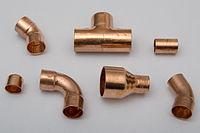
Photo from wikipedia
Abstract This paper reports a comprehensive investigation on the tensile behavior of FRP bar butt joints built with new FRP sleeves. The simplified bond-slip constitutive relationship between FRP bars and… Click to show full abstract
Abstract This paper reports a comprehensive investigation on the tensile behavior of FRP bar butt joints built with new FRP sleeves. The simplified bond-slip constitutive relationship between FRP bars and bonding medium was firstly established by using the existing research results. Based on five proposed assumptions, the stress–strain analysis of the FRP bar butt joint was performed on the FRP bar, bonding medium and sleeve under tensile load. The bond-slip behavior and the shear force between FRP bars and bonding medium were discussed in detail. According to the stress–strain analysis, the key design parameters of the FRP sleeve and the anchor length of FRP bars were determined, which is also verified by comparing test data. According to the design parameter and anchor length, two types of FRP sleeves with two different internal structures and lengths were designed, and then these FRP sleeves were made of GFRP by professional manufacturers. In addition, the axial tensile tests were conducted on a total of 10 BFRP bar butt joints, GFRP bar butt joints and CFRP bar butt joints which are connected by the proposed GFRP sleeves. Based on the test results, the failure modes of various FRP bar butt joints built with GFRP sleeves were observed, and the corresponding tensile load–displacement curves, maximum tensile load and strain were analyzed. Finally, it is found that all fractures occur on the connected FRP bars instead of the GFRP sleeves, which indicates that various FRP bars can be effectively connected by the two types of GFRP sleeves. The load–displacement curves of the GFRP sleeves exhibit a small linear elastic deformation before the FRP bars rupture. The maximum elongated length of the GFRP sleeves is only 13% of the maximum tensile displacement of FRP bar butt joints uner tensile load, while the maximum circumferential strain of GFRP sleeves is about 41.72% of their corresponding longitudinal strain.
Journal Title: Structures
Year Published: 2021
Link to full text (if available)
Share on Social Media: Sign Up to like & get
recommendations!